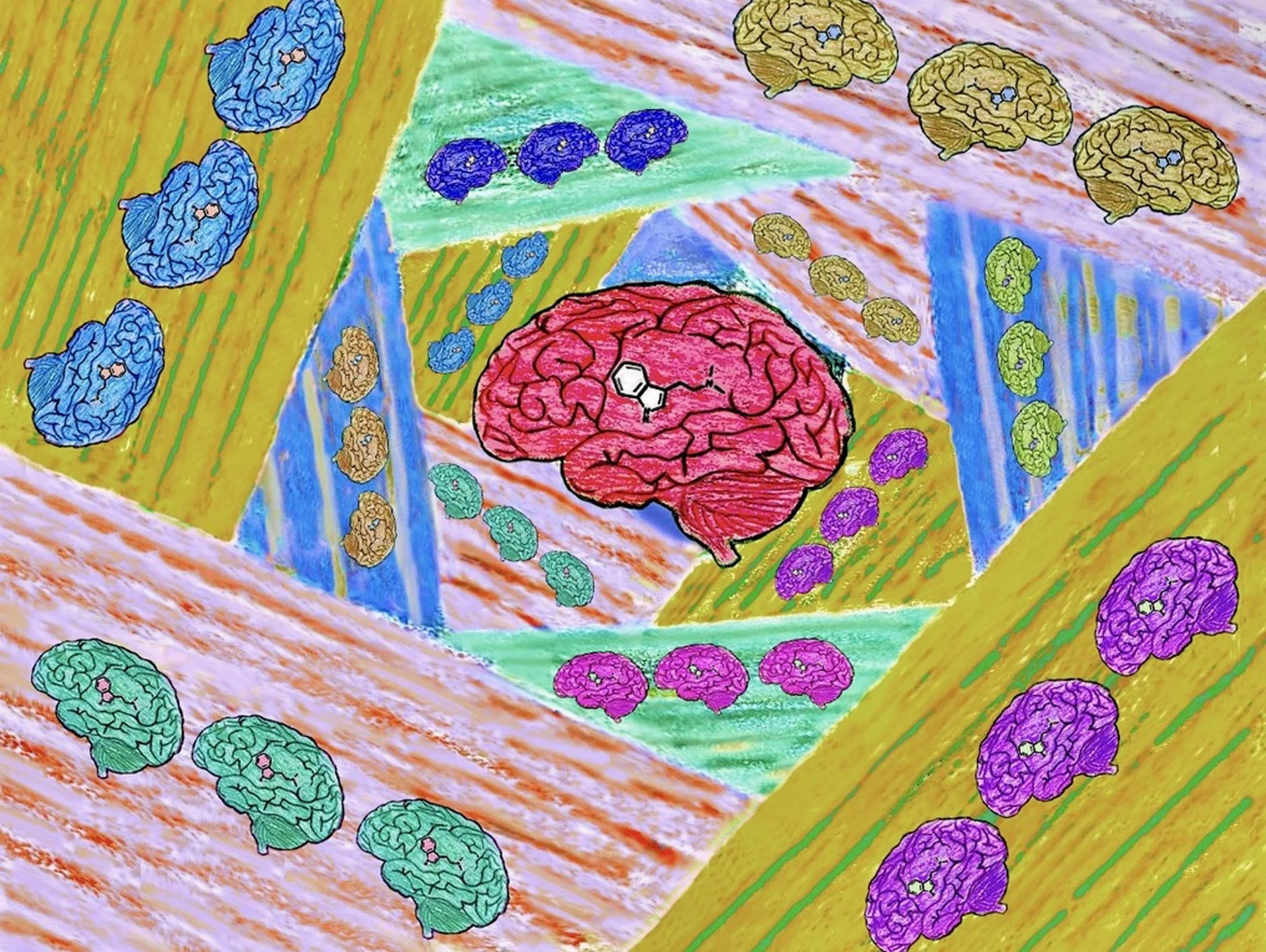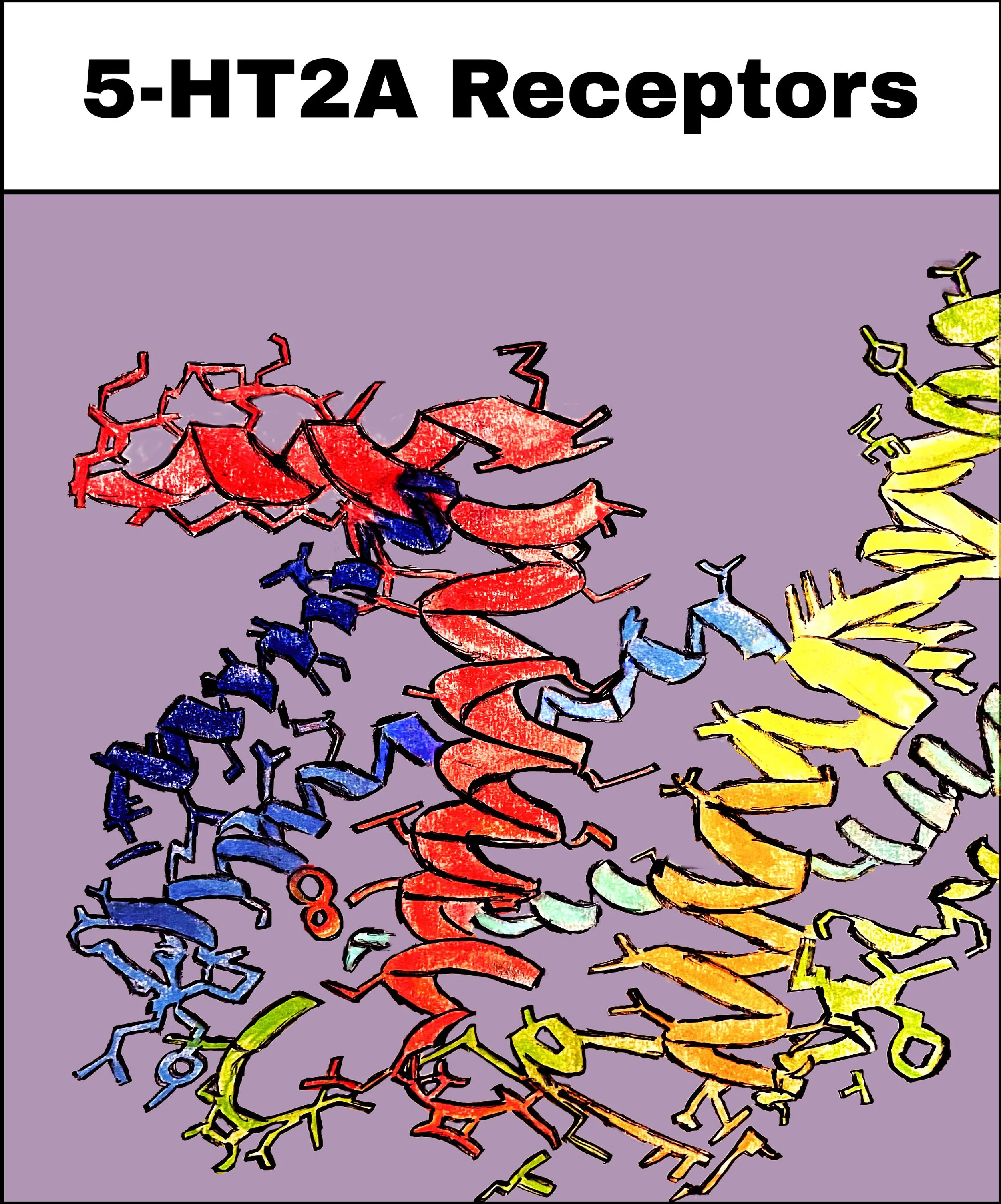DMT Unveiled: Exploring its Biological Origins, Mind-Altering Effects, and Therapeutic Potential
Author: Trisha Verma || Scientific Reviewer: Lily Bingaman || Lay Reviewer: Pranesh Rajamuthiah || General Editor: Srujana Ayyagari
Artist: Kendall White || Graduate Scientific Reviewer: Erin English
Publication Date: June 11th, 2025
Introduction
Known as “the spirit molecule,” DMT is a powerful psychedelic that has fascinated scientists and psychonauts alike. This naturally occurring compound has an extraordinary ability to alter human perception by distorting time, emotions, and the senses in ways that defy ordinary understanding. Renowned for its capacity to induce vivid, otherworldly hallucinations, DMT serves as a gateway into the mysteries of consciousness [1]. Beyond its remarkable effects, this molecule–despite being classified as an illegal substance in many countries–is sparking groundbreaking research in mental health and therapy, offering fresh perspectives for exploring the mind, healing, and the very essence of existence itself.
What is DMT?
N,N-dimethyltryptamine, most commonly known as DMT, is an alkaloid–a naturally occurring compound with at least one nitrogen atom–that is widely found in plants and animals. DMT is the primary ingredient found in ayahuasca, a well-known hallucinogen brew used for therapeutic and ritual purposes [2]. The body makes DMT from an amino acid called tryptophan, an essential amino acid that also acts as a precursor of serotonin and melatonin. This process occurs naturally in both plants and animals [1].
A DMT trip is often described as an intense and rapid shift in consciousness, characterized by vivid geometric visuals, altered perception of time and space, and profound changes in self-awareness [1]. Early research documented euphoria and anxiety as being common emotional responses. More recent studies highlight its ability to cause a complete detachment from the external world, creating an immersive, sometimes overwhelming, internal journey that feels as if one is being transported into an entirely different reality [3].
The earliest use of DMT dates back to the 15th century, when it was widely used by indigenous peoples to communicate with the gods [3]. However, the Drug Abuse Control Amendments of 1965 and the Controlled Substances Act of 1970 classified DMT as a Schedule I drug (one with no currently accepted medical use and a high potential for abuse), leading to a massive decline in psychedelic research [3]. Despite being illegal today, DMT is still widely recognized for its intense psychedelic effects and potential therapeutic benefits, which are now being reconsidered in modern scientific studies.
What Does DMT Do in the Brain?
Despite being naturally present in the body, DMT remains a mystery as its function is endogenous, or originating from within the body. It is found in low concentrations in brain tissue but has been observed to increase under certain conditions, such as stress in rodents [1]. The serotonin system is thought to be the primary mediator of DMT’s psychedelic effects [1]. Serotonin (5-HT) is a key neurotransmitter that regulates mood, appetite, sleep, memory, and overall brain function, playing a key role in emotional well-being and physiological processes [3]. The 5-HT2A receptor, a key serotonin receptor subtype, is the primary target of DMT and is heavily involved in perception, cognition, and consciousness. 5-HT2A receptor activation has been shown to facilitate synaptic plasticity in the cortex [4]. Synaptic plasticity refers to the ability of neurons to modify their connections in response to learning or environmental changes. The brain is not static; when the brain learns something new, it modifies the connections between neurons. The activation of the 5-HT2A receptor through DMT use increases the excitability of neurons and leads to the rewiring of synapses, eventually creating new communication patterns in the brain [5]. This is believed to be the reason for the intensified perception that is notable with DMT use, where users report seeing geometric patterns and vivid colors, even with their eyes closed [1].
Beyond visual distortions, 5-HT2A receptors also influence self-awareness by regulating the default mode network (DMN). The DMN is the brain’s internal monologue system and is usually active when reflecting or daydreaming [6]. Psychedelics, such as DMT, tend to disrupt the DMN, leading to ego dissolution–the sense that the boundary between oneself and the world has melted away [7].
Another key effect of 5-HT2A activation is that it enhances cross-talk between normally separate brain regions, leading to an increase in global functional connectivity (GFC) [1]. GFC refers to the overall level of communication and synchronization between different regions of the brain [8]. Electroencephalogram (EEG) studies on DMT’s effects have revealed that different brain regions begin to communicate more freely than typical [9]. Ordinarily, the brain operates in a structured manner, with distinct areas responsible for specific functions, such as vision, movement, and memory. When GFC is high, brain areas that typically function independently begin to interact in a dynamic manner, leading to a fluid and integrated cognitive state. This integration can result in sensory cross-talk. For example, the visual and auditory networks overlap and potentially cause users to hear colors or see music–a phenomenon called synesthesia [10]. DMT’s interaction with the brain–particularly through 5-HT2A receptor activation–reveals its powerful ability to reshape neural communication and consciousness, offering profound insights into the brain’s plasticity and the nature of human awareness.
The Applications and Uses of DMT
Beyond its intense effects, researchers are investigating how DMT’s ability to rapidly alter cognition and perception can be harnessed for therapeutic benefits, particularly in addressing treatment-resistant mental health conditions. DMT has a rapid onset and short duration (20-30 minutes) that makes it practical for clinical use when compared to longer-acting psychedelics, like MDMA and LSD (4-6 hours and 8-12 hours, respectively) [11].
A recent study showed that DMT significantly reduced the severity of depression symptoms. In this placebo-controlled study, one group of participants received the actual treatment and another group received a placebo–a substance with no therapeutic effect, often used as a control. The study was also prospective, meaning the data was collected through follow-ups with participants over a period of time [12]. Participants who received DMT showed notable improvements in depression scores, with effects observed one to two weeks after administration. However, trait anxiety levels remained unchanged, suggesting that while DMT may alleviate depressive symptoms, its effects on anxiety are not yet understood. Interestingly, participants who experienced “oceanic boundlessness [and] a sense of unity and ego dissolution,” reported greater reductions in depression, indicating that the nature of the psychedelic experience may contribute to its therapeutic effects [12].
In another study, male and female rats were subjected to chronic and intermittent administration of low doses of DMT. This dosing schedule is considered “microdosing” and it's believed to have beneficial effects on mood, anxiety, and cognition. The study tested this hypothesis and found that the low doses of DMT produced an antidepressant-like phenotype, without affecting memory or social interaction in the tested rats. This suggests that DMT may help alleviate symptoms of mood and anxiety disorders [13].
A recent case study explored DMT’s potential for treating symptoms of post-traumatic stress disorder (PTSD). PTSD is a mental health condition that can develop after experiencing traumatic experiences, such as war, abuse, or natural disasters. In the study, a participant received a single dose of DMT, which resulted in a significant reduction in feelings of “hopelessness and related suicide risk” [14]. However, a follow-up three months later revealed the onset of new night terrors, suggesting that the therapeutic effects of DMT may be temporary and only last a few months [14].
Conclusion and Limitations
Despite its promising potential, DMT still requires extensive scientific research on its short-term and long-term effects on the brain to fully understand its therapeutic benefits and limitations. Research suggests that DMT may help alleviate the symptoms associated with conditions like depression, anxiety, and PTSD, by promoting neuroplasticity and facilitating deep psychological experiences. Additionally, its naturally occurring presence in the human body raises fascinating questions about its role in consciousness and brain function. However, significant barriers remain, including restricting research and clinical applications. Until more rigorous clinical trials are carried out to establish the safety and long-term effects of DMT, it remains a powerful but largely unexplored tool in the field of mental health and neuroscience.
References
Carbonaro, T. M., & Gatch, M. B. (2016). Neuropharmacology of N,N-dimethyltryptamine. brain research bulletin, National Library of Medicine, 126(1), 74–88. https://doi.org/10.1016/j.brainresbull.2016.04.016
dos Santos, R. G., Bouso, J. C., & Hallak, J. E. C. (2017). Ayahuasca, dimethyltryptamine, and psychosis: a systematic review of human studies. Therapeutic Advances in Psychopharmacology, 7(4), 141–157. https://doi.org/10.1177/2045125316689030
Cameron, L. P., & Olson, D. E. (2018). Dark classics in chemical neuroscience: N,N-Dimethyltryptamine (DMT), ACS Chemical Neuroscience, 9(10), 2344–2357. https://doi.org/10.1021/acschemneuro.8b00101
Zhang, G., & Stackman, R. W. (2015). The role of serotonin 5-HT2A receptors in memory and cognition. Frontiers in Pharmacology, 6(225). https://doi.org/10.3389/fphar.2015.00225
Stampanoni Bassi, M., Iezzi, E., Gilio, L., Centonze, D., & Buttari, F. (2019). Synaptic plasticity shapes brain connectivity: Implications for network topology, International Journal of Molecular Sciences, 20(24), 6193. https://doi.org/10.3390/ijms20246193
Gillespie, C. F., Szabo, S. T., Nemeroff, C. B. (2020). Unipolar Depression. Rosenberg’s Molecular and Genetic Basis of Neurological and Psychiatric Disease, 2, pp. 613–631, https://doi.org/10.1016/b978-0-12-813866-3.00036-9.
Letheby, C., & Gerrans, P. (2017). Self unbound: ego dissolution in psychedelic experience, Neuroscience of Consciousness, 2017(1). https://doi.org/10.1093/nc/nix016
Madero, B., Sodoma, M., Oehler, C., Magnotta, V. A., Long, J. D., Hazeltime, E., & Voss, M. W. (2023). Global functional connectivity of cognitive control network predicts task-switching performance in older adults. Biorxiv, 21, https://doi.org/10.1101/2023.11.20.567605.
Timmermann, C., Roseman, L., Haridas, S., Rosas, F. E., Luan, L., Kettner, H., Martell, J., Erritzoe, D., Tagliazucchi, E., Pallavicini, C., Girn, M., Alamia, A., Leech, R., Nutt, D. J., & Carhart-Harris, R. L. (2023). Human brain effects of DMT assessed via EEG-fMRI, Proceedings of the National Academy of Sciences, 120(13). https://doi.org/10.1073/pnas.2218949120
Cohen, J. R., & D’Esposito, M. (2016). The segregation and integration of distinct brain networks and their relationship to cognition, Journal of Neuroscience, 36(48), 12083–12094. https://doi.org/10.1523/jneurosci.2965-15.2016
Chaves, C., Rafael, Dursun, S. M., Massimo Tusconi, Carta, M. G., Brietzke, E., & Jaime. (2024). Why N,N-dimethyltryptamine matters: unique features and therapeutic potential beyond classical psychedelics, Frontiers in Psychiatry, 15. https://doi.org/10.3389/fpsyt.2024.1485337
Timmermann, C., Zeifman, R. J., Erritzoe, D., Nutt, D. J., & Carhart-Harris, R. L. (2024). Effects of DMT on mental health outcomes in healthy volunteers, Scientific Reports, 14(1), 3097. https://doi.org/10.1038/s41598-024-53363-y
Cameron, L. P., Benson, C. J., DeFelice, B. C., Fiehn, O., & Olson, D. E. (2019). Chronic, intermittent microdoses of the psychedelic N,N-Dimethyltryptamine (DMT) produce positive effects on mood and anxiety in rodents, ACS Chemical Neuroscience, 10(7), 3261–3270. https://doi.org/10.1021/acschemneuro.8b00692
Ragnhildstveit, A., Khan, R., Seli, P., Bass, L. C., August, R. J., Kaiyo, M., Barr, N., Jackson, L. K., Gaffrey, M. S., Barsuglia, J. P., & Averill, L. A. (2023). 5-MeO-DMT for post-traumatic stress disorder: a real-world longitudinal case study. Frontiers in Psychiatry, 14, 1271152. https://doi.org/10.3389/fpsyt.2023.1271152



